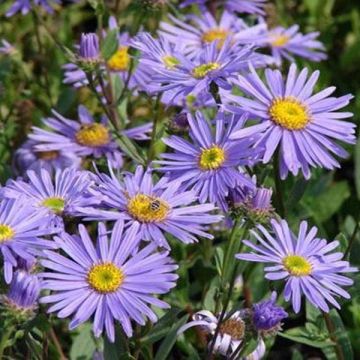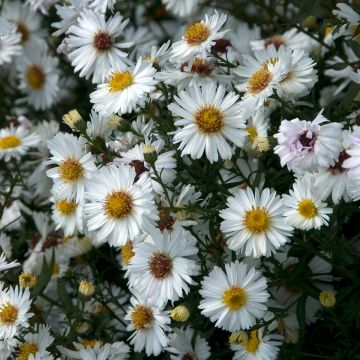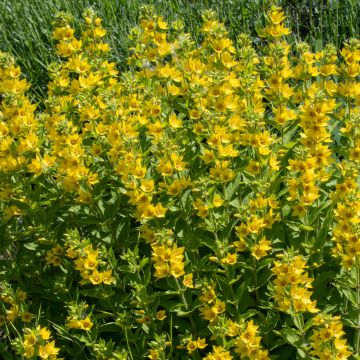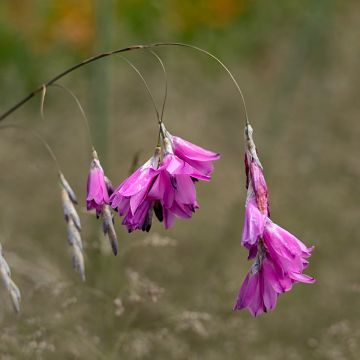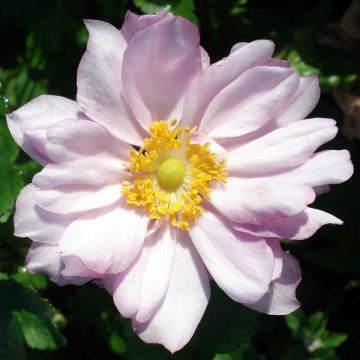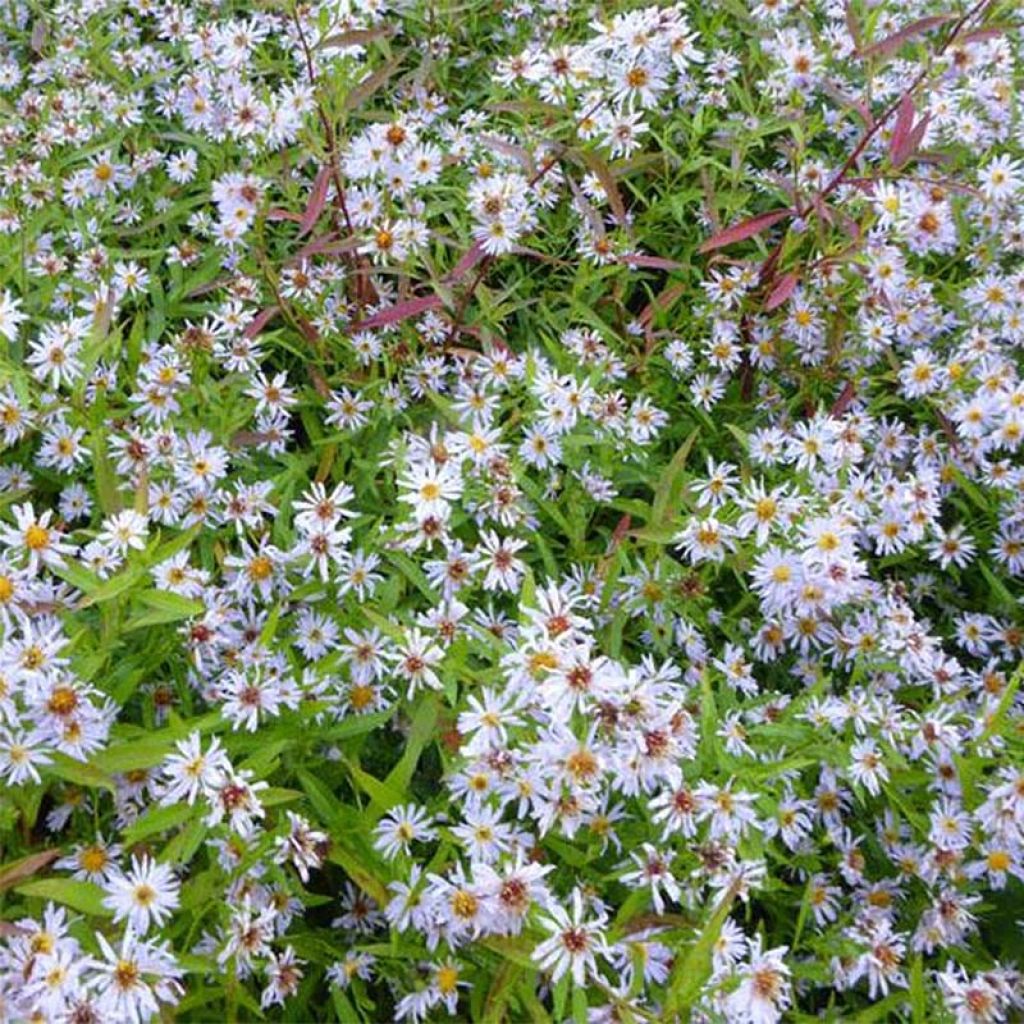

Aster versicolor Altweibersommer
Aster versicolor Altweibersommer
Aster x versicolor Altweibersommer
Michaelmas Daisy
She is growing well, it's great to see the new shoots.
Marié Josee A., 29/03/2020
This item cannot be shipped to the selected country
Delivery charge from €5.90
More information
Delivery charge from €5.90
More information
Schedule delivery date,
and select date in basket
This plant carries a 12 months recovery warranty
More information
We guarantee the quality of our plants for a full growing cycle, and will replace at our expense any plant that fails to recover under normal climatic and planting conditions.
From €5.90 for pickup delivery and €6.90 for home delivery
Express home delivery from €8.90.
Does this plant fit my garden?
Set up your Plantfit profile →
Description
Aster x versicolor 'Altweibersommer' is an old hybrid variety that combines the qualities of its parents: the long flowering of Aster laevis and the vigour of the New York Aster. This large perennial plant has a long, abundant flowering from late summer to autumn, bearing a cloud of pale blue-mauve stars with yellow centres which turn purple. An undemanding aster, resilient to bad weather and easy to grow in any good well-draining garden soil, even limestone or clay. It has a wild and subtle charm, magnificent in the background of a border.
Aster or Symphyotrichum x versicolor belongs to the Asteraceae family. It is the result of spontaneous cross-breeding between Aster laevis and A. novi-belgii L and resembles its second parent most. 'Altweibersommer' was selected in Germany in 1949, by Karl Foerster. This perennial has an upright and bushy tufted habit. It will reach a minimum height of 90 cm (35in) when in flower and rapidly spread at least 70 cm (28in). The airy and generous flowering is loved by bees and butterflies and lasts from August to October. The light flower heads are pale blue-mauve, about 4 cm (2in) in diameter. The centre gradually changes colour from bright yellow to red-purple. The glaucous stems are strong and branching with quite thin, medium-green leaves. The basal leaves are lanceolate and toothed. This plant spreads rapidly so provide enough space to accommodate it in the garden.
It is impossible to imagine our gardens without asters and this one is particularly generous and vigorous. It pairs well with Salvia microphylla with intense magenta flowers, Helianthus 'Lemon Queen' and tall rudbeckias. The aster genus is extremely diverse, with a wide range of varied colours and sizes, suitable for all types of soils. Depending on the species and varieties, it is possible to extend the flowering from spring to the end of autumn. Amateur gardeners who love these lovely, rustic daisy-like flowers can enjoy them for a large part of the year, in the garden and in bouquets.
Aster versicolor Altweibersommer in pictures




Flowering
Foliage
Plant habit
Botanical data
Aster
x versicolor
Altweibersommer
Asteraceae
Michaelmas Daisy
(laevis x novi-belgii)
Cultivar or hybrid
Other Asters
Planting and care
Plant Aster versicolor in autumn or spring in any good garden soil that is not too acidic or too chalky, well-worked and loose and not too poor. It thrives in soils that stay moist even in summer and likes full sun. You may need to stake the plant depending on its growth (rich soil will produce a lush but less sturdy plant). Avoid strong winds that may flatten the clumps. Avoid moving it once established as it does not tolerate this well. In a mass planting, leave at least 80 cm (32in) between plants to allow it to spread through its rhizomes. Divide the clumps every three or four years to keep them floriferous. This aster is resistant to diseases but may be prone to powdery mildew in soil that is too dry and poor.
Planting period
Intended location
Care
-
, onOrder confirmed
Reply from on Promesse de fleurs
Summer flowering perennials
Haven't found what you were looking for?
Hardiness is the lowest winter temperature a plant can endure without suffering serious damage or even dying. However, hardiness is affected by location (a sheltered area, such as a patio), protection (winter cover) and soil type (hardiness is improved by well-drained soil).

Photo Sharing Terms & Conditions
In order to encourage gardeners to interact and share their experiences, Promesse de fleurs offers various media enabling content to be uploaded onto its Site - in particular via the ‘Photo sharing’ module.
The User agrees to refrain from:
- Posting any content that is illegal, prejudicial, insulting, racist, inciteful to hatred, revisionist, contrary to public decency, that infringes on privacy or on the privacy rights of third parties, in particular the publicity rights of persons and goods, intellectual property rights, or the right to privacy.
- Submitting content on behalf of a third party;
- Impersonate the identity of a third party and/or publish any personal information about a third party;
In general, the User undertakes to refrain from any unethical behaviour.
All Content (in particular text, comments, files, images, photos, videos, creative works, etc.), which may be subject to property or intellectual property rights, image or other private rights, shall remain the property of the User, subject to the limited rights granted by the terms of the licence granted by Promesse de fleurs as stated below. Users are at liberty to publish or not to publish such Content on the Site, notably via the ‘Photo Sharing’ facility, and accept that this Content shall be made public and freely accessible, notably on the Internet.
Users further acknowledge, undertake to have ,and guarantee that they hold all necessary rights and permissions to publish such material on the Site, in particular with regard to the legislation in force pertaining to any privacy, property, intellectual property, image, or contractual rights, or rights of any other nature. By publishing such Content on the Site, Users acknowledge accepting full liability as publishers of the Content within the meaning of the law, and grant Promesse de fleurs, free of charge, an inclusive, worldwide licence for the said Content for the entire duration of its publication, including all reproduction, representation, up/downloading, displaying, performing, transmission, and storage rights.
Users also grant permission for their name to be linked to the Content and accept that this link may not always be made available.
By engaging in posting material, Users consent to their Content becoming automatically accessible on the Internet, in particular on other sites and/or blogs and/or web pages of the Promesse de fleurs site, including in particular social pages and the Promesse de fleurs catalogue.
Users may secure the removal of entrusted content free of charge by issuing a simple request via our contact form.




































